Fencing
Bamboo makes a great fencing material because it is a fast-growing, renewable resource that is extremely hardy and structurally strong. We follow in the footsteps of traditional Asian designed fences from over 500 years ago. Then we add our own modern-day elements to create a product that will withstand the test of time.
Originally a bright manila, the color of our fences softens naturally over time into a light gray. This natural aging acknowledges the passage of time, an important facet in many traditional gardens. As bamboo can split in random spots, we pre-split our poles, keeping our panels looking gorgeous for years to come. We utilize tan-colored screws, brass wire, and durable plastic ties to bring these ancient designs into the modern moment. All of our fencing is made in America.
Although we specialize in bamboo fencing, our team has the expertise to assist with your traditional cedar fencing projects as well.
Fencing Specs
Height and Running Length: Standard height is 4 or 6 feet depending on the style of fencing. Anything over 6 feet may require a variance or agreement from neighboring properties.
Footers: For some fences, metal is inconspicuously installed within the bamboo poles for structure. Otherwise, wooden pressure treated or cedar posts are used.
Black Ties: Ties are available either in traditional (black hemp palm rope) or modern (black woven polypropylene plastic). These traditional ties can last half a dozen years depending on the environment; our modern ties can last over twice as long as their natural fiber counterparts.
Polyurethane: We suggest our time-tested protective layer of polyurethane be added before the fencing leaves our workshop.


Four-Eyed Fence
(Yotsume-Gaki • 四目垣)
A stick fence for defining a pathway.
Standard Size: 48″ tall x 96″ wide
The four-eyed fence is the most popular fence design in Japan. It is a fairly simple, view-through style fence; however, it requires skill to make it attractive. The purpose of the four-eyed fence is to add space, elegance, and beauty. The spacing of both the rails and pickets is entirely dependent on the space that the fence will be occupying, the thickness of the bamboo, and the whims of the designer. The number of pickets is occasionally increased, but never to the point that the fence becomes a screen. The vertical pickets alternate between the front and rear of the rails.
Options:
• Traditional black hemp ties or modern polypropylene ties
• Black plastic coated metal mesh
• Single, double, or triple pickets
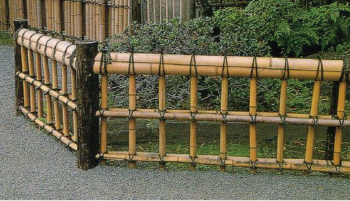
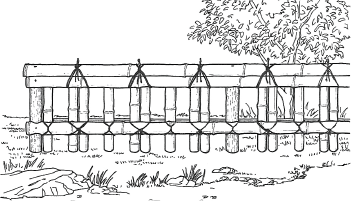
Rail Fence
(Kinkakuji-Gaki • 金閣寺垣)
A low fence for controlling foot traffic.
Standard Size: 30” tall x 96″ wide
The Rail Fence has a bold look for a fence that is smaller in stature. It is the most common thigh-high fencing style found in Japan, and is very sturdy due to its simple design, stout height and the thickness of the bamboo used to construct it. It is frequently placed along a walkway or to define the garden. The open design allows you to view your garden while still keeping foot traffic away from your beautiful plants.
Options:
• Traditional black hemp ties or modern polypropylene ties
• Black plastic coated metal mesh
• Alternating double pickets
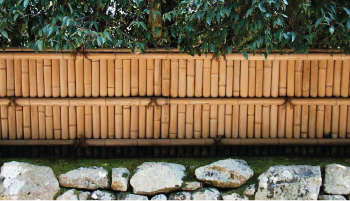

Short Slat Fence
(Ginkakuji-Gaki • 銀閣寺垣)
A short fence for view screening.
Standard Size: 36″ tall x 96″ wide
This screening style fence is basically a short version of the “flat slat” style. It gets its name from the famous Jishoiji temple (commonly referred to as Ginkakuji) in Kyoto, Japan. The fence is traditionally used to line hill peaks and the tops of rock walls.
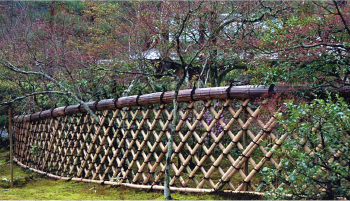
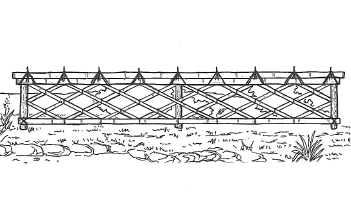
Diamond Fence
(Ryoanji-Gaki • 竜安寺垣)
Decorative fence for pathway definition and partial view screening.
Standard Size: 36″ tall x 96″ wide
The diamond fence is a less common, knee-high fence style. The unique shape is formed by diagonal bamboo slats and adds more complexity and elegance than vertical styles of fencing.

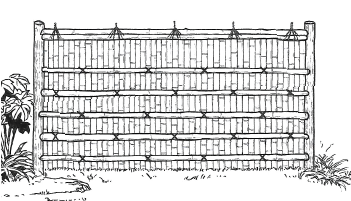
Flat Slat Fence
(Kenninji-Gaki • 建仁寺垣)
A full cover fence of bamboo slats.
Standard Size: 72″ tall x 96″ wide
The slat fence is very simple but maintains an impressive look. It is the most common screening style fence found in Japan and is almost always tall. The use of straight, consistent slats makes this fence the most privacy-providing of the bamboo fence designs. The thick half-rounds that are used for the horizontal rails only add to the robust constitution of the slat fence.
Options:
• Single or double sided
• Horizontal bamboo half rounds
• Traditional black ties
• Slat window on upper portion


Rifle Barrel Fence
(Teppo-Gaki • 鉄砲垣)
A partial cover fence of bamboo poles.
Standard Size: 60″ tall x 96″ wide
The rifle barrel fence is similar in style to the four-eyed fence, except that it consists of a greater number of pickets, thus making it a screening fence. The vertical pickets are placed to the front and rear of the rails, alternatively. The number of pickets is decided by the designer and the requirements of the space being filled.


Screening Fence
(Misu-Gaki • 御簾垣)
Tall fence with full view screening.
Standard Size: 72″ tall x 96″ wide
This is a tall screening fence with pickets that run horizontally. The pickets are fitted into grooves that are cut into the vertical beams. This fence is used for privacy. It is considered a dignified design since it originates from screens that were used in the homes of nobles in ancient Japan.


Wave Fence
(Otsu-Gaki • 大津垣)
An intricate woven fence.
Standard Size: 72″ tall x 96″ wide
This beautiful, tall fence gets its name from the city of Otsu, where it was first used to line a well-traveled road. It consists of bamboo slats that are woven in alternating directions, between horizontal bamboo rails. Both the rails and vertical woven slats can be in sets or as a single piece. The design is highly customizable.
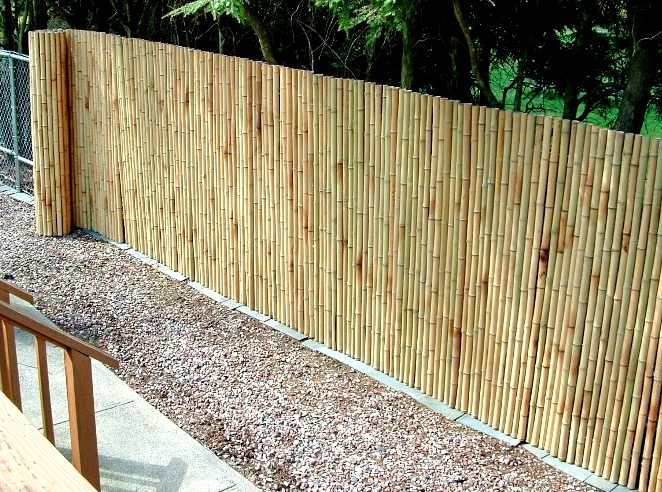
Rolled Fence
Rolled Bamboo Fencing
Standard Size: 48” or 72” tall x 72” wide
Constructed with 1” rounds of bamboo and galvanized metal wires, our rolled fencing is a versatile and budget friendly option perfectly suited for a variety of applications.
